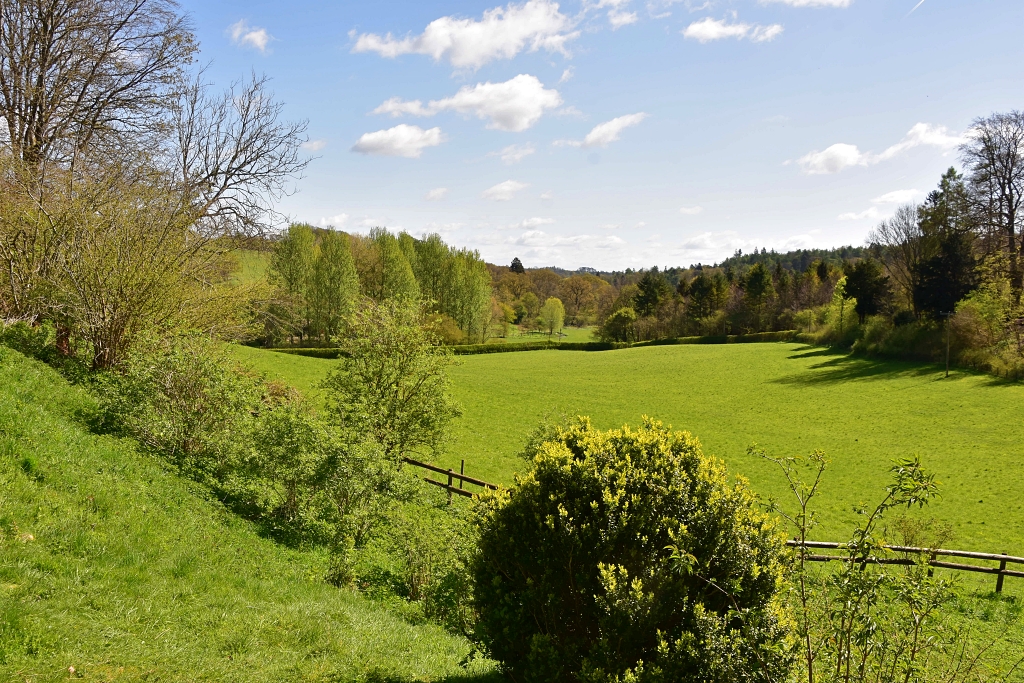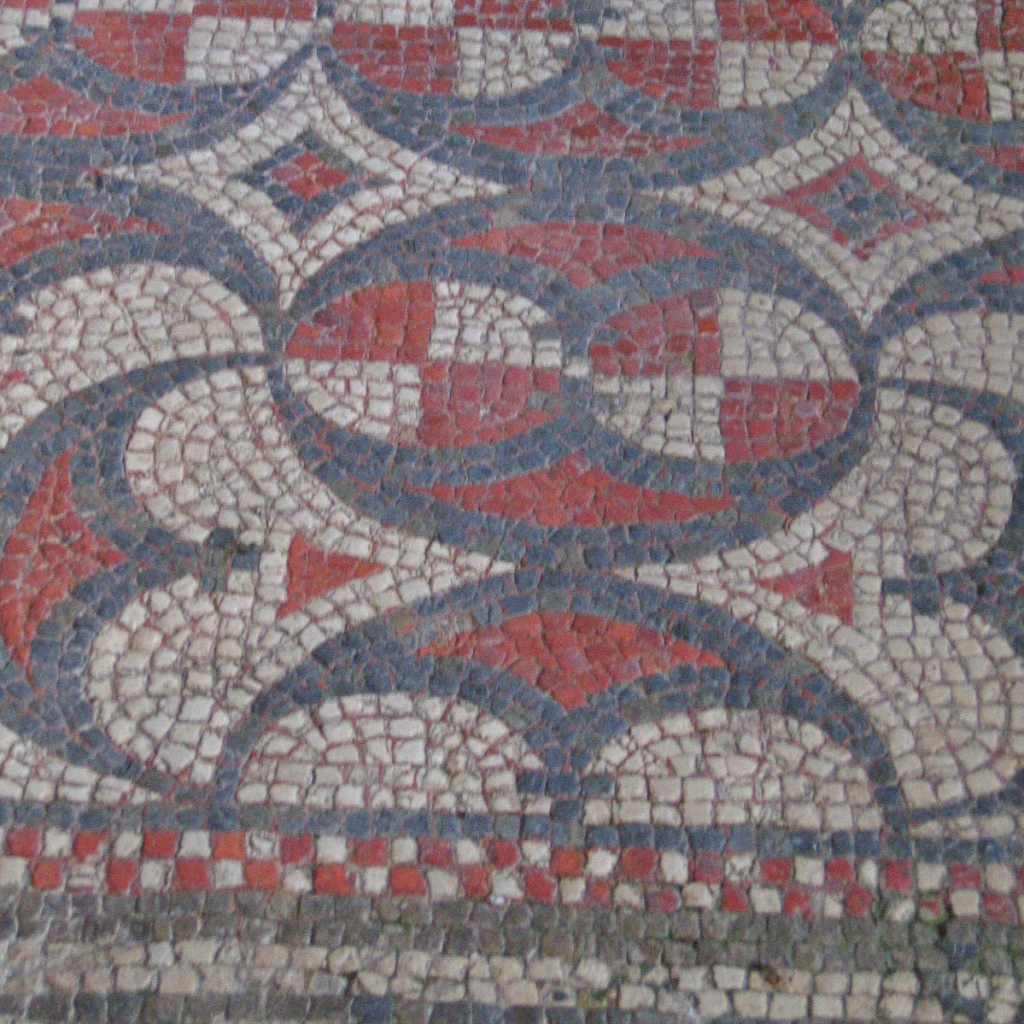Exploring Roman Britain:
Chedworth Roman Villa
Hidden away in a beautiful wooded valley in the Cotswolds lies one of England’s most important Romano-British villa discoveries. The ruins of Chedworth Roman Villa were found and first excavated in 1864 and have been on public display ever since. They are now in the care of the National Trust and have been conserved for future generations. A substantial part of the site has been enclosed, which allows visitors the chance to view the high-status mosaic floors, hypocaust heating system, and luxurious bath house more closely. There is also a museum that displays many of the Roman finds discovered during the excavations.
I can’t emphasise enough how lovely and peaceful this Cotswolds valley is. Gently rolling hills, fertile soil, and the pretty River Coln are the most likely reasons the Romans built their villa here. It’s a stunning area and adding a walk in the local countryside to your villa exploration is time well spent! Just be careful travelling to the site, as the roads are mostly single track and rather twisty!
We visited Chedworth Roman Villa on a hot, sunny day that was also a special event day with a Roman army camp re-enactment. The National Trust organises a whole range of special events throughout the year, and these add to the interest and give the site a more Roman feel. We were able to walk around the Roman army camp, inspect their clothing and weapons, and get an appreciation of the types of food they ate and life they led. There was even a doctor's surgery display which had some very gruesome looking tools on show. Yuk!
 Valley View from the End of the North Range © essentially-england.com
Valley View from the End of the North Range © essentially-england.comChedworth Roman Villa Highlights
Chedworth Roman Villa is famous for the quality of the mosaic floors that were uncovered during the excavations. The patterns and colours are amazing and prove that this was a high-status villa owned by a wealthy Roman family.
The villa started life as a much humbler structure consisting of three simple detached buildings. Evidence found during the excavations suggests that these earlier rooms date from the 2nd century AD. Over the next few hundred years the buildings were extended and improved, until - in its heyday, around the year 370 AD - Chedworth Roman Villa was a comfortable and luxurious home.
Mosaic Floors at Chedworth
 © essentially-england.com
© essentially-england.com © essentially-england.com
© essentially-england.comAfter the Roman Army left in 410AD, many buildings in Roman Britain fell into decline, and eventual ruin. Chedworth seems to have been an exception. Carbon-dated samples from one floor showed that it was laid in the 5th century, after the retreat of the Roman Army. The floor was of lower quality than the older mosaics, but it shows that the owners were still living at Chedworth and were still repairing or improving their home.
It doesn't seem to have been a common occurrence, though, because this is the only 5th century mosaic floor found in Britain so far!
 © essentially-england.com
© essentially-england.com © essentially-england.com
© essentially-england.comHypocaust Floor
On show at Chedworth Roman Villa was a great example of a hypocaust underfloor heating system. Rows of stone pillars stood like mushrooms and supported the floor of the room above. Heat from an external fire flowed beneath the floor, and possible up vents in the walls, to keep the room nice and warm during the coolest months. Servants tended the fires, collecting and chopping wood and peat, and ensuring the fires didn't go out.
 Chedworth Roman Villa Hypocaust Floor
Chedworth Roman Villa Hypocaust Floor © essentially-england.com
The Shrine
 The Shrine at Chedworth Roman Villa
The Shrine at Chedworth Roman Villa © essentially-england.com
Freshwater springs were important to the Romans, and they often made a feature of them, both for bathing and as a place to worship one of their many gods.
At Chedworth Roman Villa, an octagonal stone basin collects the natural spring water and it was used as a shrine to female spirits or nymphs. The villa's inhabitants made offerings to the spirits in return for blessings and a happy, healthy life.
While the shrine was a sacred space the Romans, being practical, pragmatic people, then directed the water from the shrine towards the villa for cooking and drinking, the baths, and the toilets.
Roman Army
 Roman Re-enactors at Chedworth Roman Villa
Roman Re-enactors at Chedworth Roman Villa © essentially-england.com
 Roman Army Attack Formation
Roman Army Attack Formation © essentially-england.com
During our visit, we had the chance to look around the camp of a Roman army re-enactment group - which was utterly fascinating. The reenactors study Roman life and history and try to live exactly like the Romans would have. Right down to creating authentic costumes and equipment from shoes to armour. In camp, they lived, ate, and rested as Roman legionary would have done. During the day they practised battle tactics and exercised.
Roman Doctor
 The Operating Table of a Roman Doctor
The Operating Table of a Roman Doctor © essentially-england.com
 Doctor's Tools on Display at Chedworth Roman Villa
Doctor's Tools on Display at Chedworth Roman Villa © essentially-england.com
There were also intriguing, if rather grisly, demonstrations from the Roman doctor. The Romans learned most of their medical skills from the more advanced Greeks. Each Roman military unit, whether in camp or on the march, would have had a doctor in its ranks to deal with any injuries or illnesses. The doctors worked used plants and minerals to concoct salves and tinctures. They could set broken bones, pull teeth, remove tonsils, and repair hernias. They also amputated limbs if needed - though a lack of hygiene meant surgery was hazardous and often fatal, and there wasn’t always a good supply of poppy-based sedative!
For more information about opening times and events at Chedworth Roman Villa please refer to the National Trust website.
 Chedworth Roman Villa Site in Springtime © essentially-england.com
Chedworth Roman Villa Site in Springtime © essentially-england.comVisiting Gloucestershire?
Where You Could Stay
Gloucestershire is a great destination whether you want get-away-from-it-all peace, quiet walks and tiny villages, or high fashion shopping and a bit of excitement. Throw in Evensong at Gloucester Cathedral, a ruined abbey or two, racing at Cheltenham and some fantastic local food and you're all set for a weekend or a holiday that has something for everyone whether you're a couple in need of romance or a family in need of fun.
Gloucestershire has its fair share of beautiful apartments and holiday cottages, and here are a couple of ideas where you could stay:
To see other holiday cottages in Gloucestershire click here. Or check out holiday cottages in other parts of England by clicking here.
If you need to find a hotel, then try one of these search platforms...
What You Could See and Do
Explore the regency splendours of Cheltenham, take a walk along the Gloucester and Sharpness Canal or enjoy a long lazy lunch in the very pretty village of Frampton on Severn.
Ride on a steam train or watch some horse racing at Cheltenham's famous race course.
Visit The Slimbridge Wetland Centre. Explore its connection with Scott of the Antarctic and marvel at the variety of birds it attracts.
Spend a day meandering through the Cotswolds lanes. Stop off for ice cream at Lower Slaughter, feed the trout at Bibury, visit the Saxon Church at Duntisbourne Rouse or enjoy the wonderful garden at Hidcote Manor.
Return from our Chedworth Roman Villa page to the Gloucestershire page here.


















